RMIT NURS1131 Media Analysis Report: Code Blue Scenario Analysis
VerifiedAdded on 2022/08/27
|9
|2729
|13
Report
AI Summary
This report provides a detailed analysis of a Code Blue scenario, focusing on the performance of healthcare professionals during a simulated medical emergency. The report meticulously examines the actions taken by the medical personnel, identifying both strengths and weaknesses in their execution of Basic Life Support (BLS) and Advanced Life Support (ALS) protocols. It highlights deviations from the Australian Resuscitation Council (ARC) guidelines, specifically addressing issues such as the failure to check for danger, poor dynamic decision-making, inadequate airway assessment, improper ventilation techniques, and incorrect chest compression rates and depths. The report also critiques the intubation process, highlighting errors in technique and situational awareness. Through a comprehensive review of the video, the report emphasizes the importance of adherence to established protocols and the impact of these actions on patient outcomes, offering recommendations for improved practice and adherence to ARC guidelines. The report supports its findings with references to relevant research and guidelines.
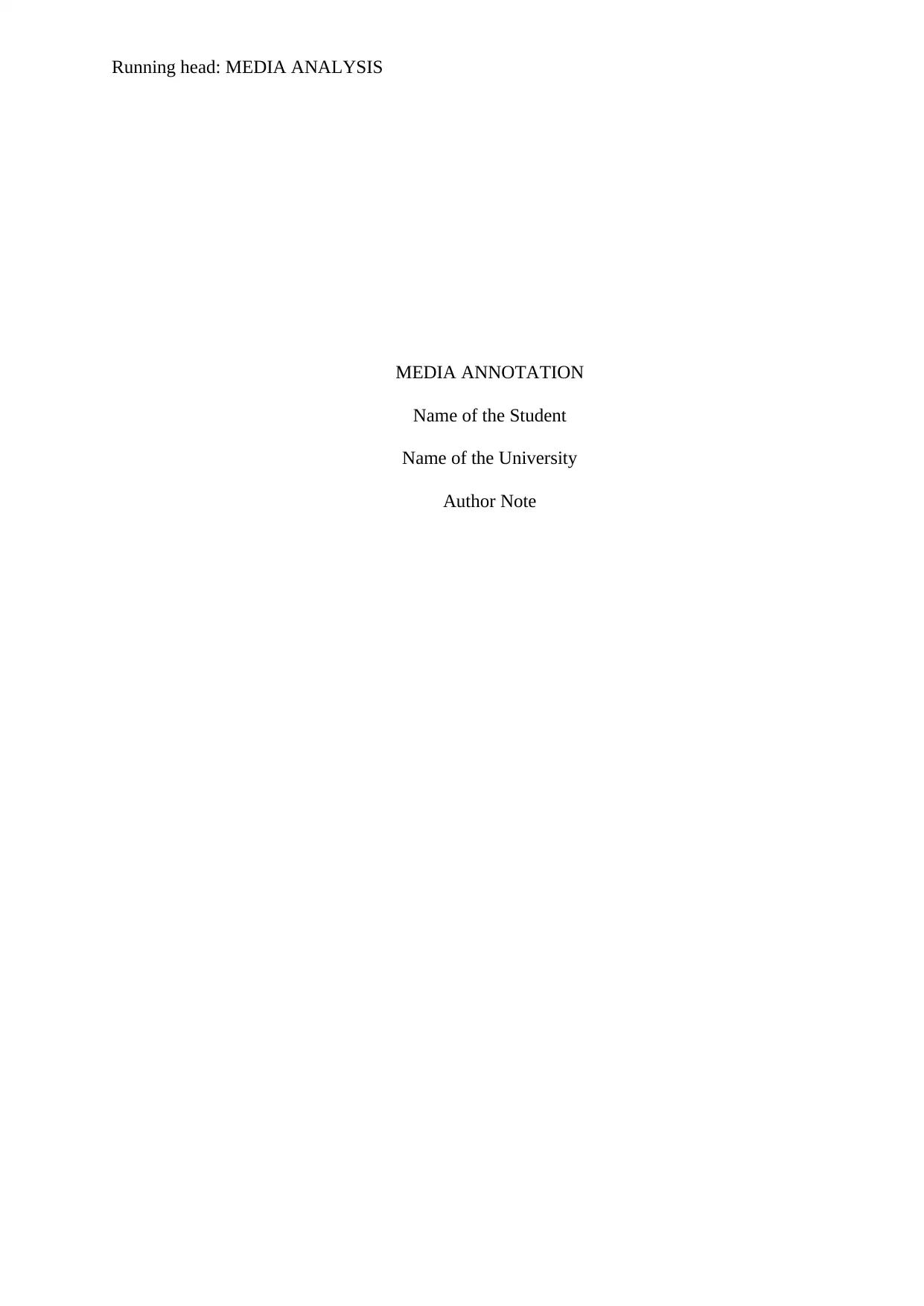
Running head: MEDIA ANALYSIS
MEDIA ANNOTATION
Name of the Student
Name of the University
Author Note
MEDIA ANNOTATION
Name of the Student
Name of the University
Author Note
Paraphrase This Document
Need a fresh take? Get an instant paraphrase of this document with our AI Paraphraser
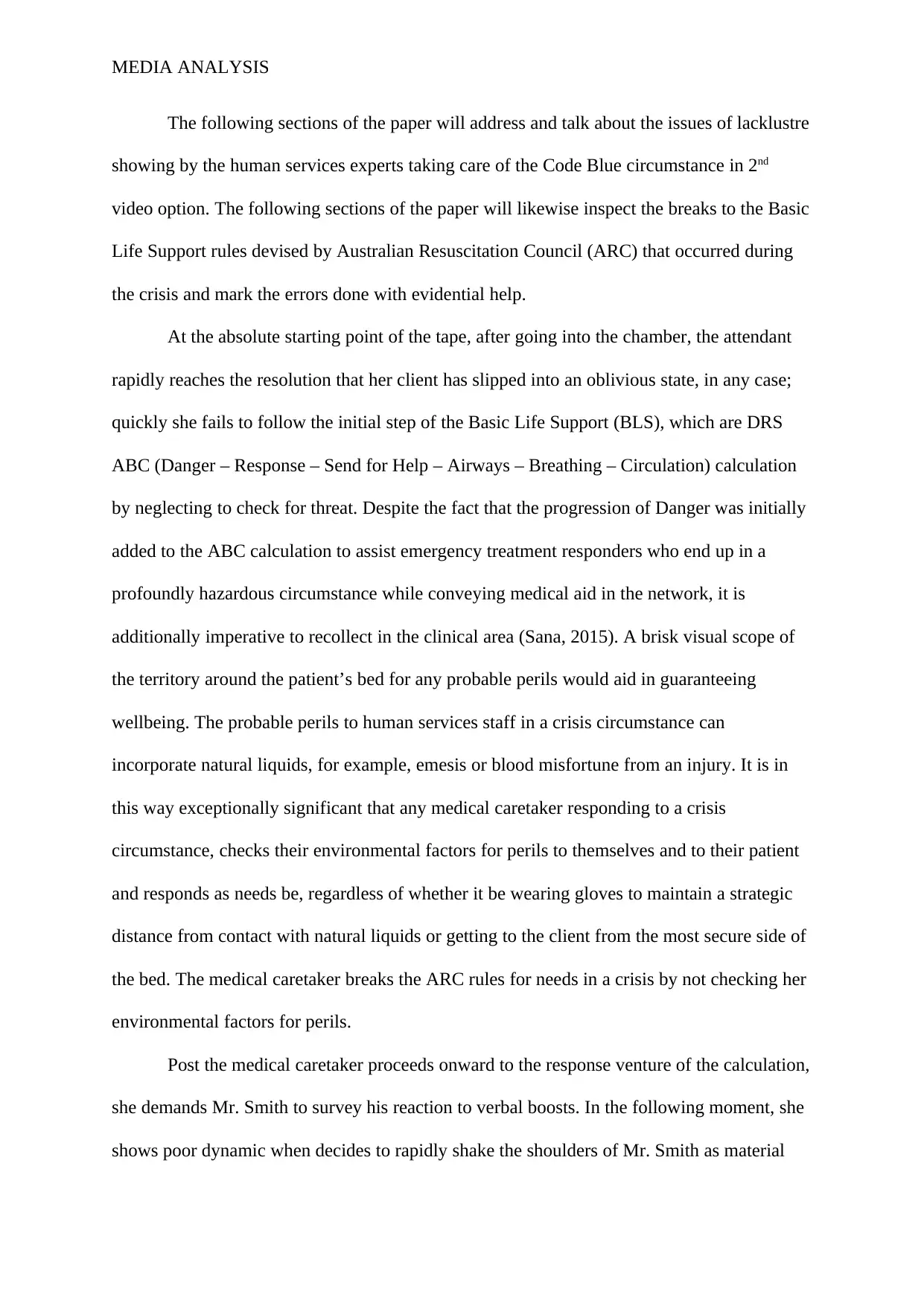
MEDIA ANALYSIS
The following sections of the paper will address and talk about the issues of lacklustre
showing by the human services experts taking care of the Code Blue circumstance in 2nd
video option. The following sections of the paper will likewise inspect the breaks to the Basic
Life Support rules devised by Australian Resuscitation Council (ARC) that occurred during
the crisis and mark the errors done with evidential help.
At the absolute starting point of the tape, after going into the chamber, the attendant
rapidly reaches the resolution that her client has slipped into an oblivious state, in any case;
quickly she fails to follow the initial step of the Basic Life Support (BLS), which are DRS
ABC (Danger – Response – Send for Help – Airways – Breathing – Circulation) calculation
by neglecting to check for threat. Despite the fact that the progression of Danger was initially
added to the ABC calculation to assist emergency treatment responders who end up in a
profoundly hazardous circumstance while conveying medical aid in the network, it is
additionally imperative to recollect in the clinical area (Sana, 2015). A brisk visual scope of
the territory around the patient’s bed for any probable perils would aid in guaranteeing
wellbeing. The probable perils to human services staff in a crisis circumstance can
incorporate natural liquids, for example, emesis or blood misfortune from an injury. It is in
this way exceptionally significant that any medical caretaker responding to a crisis
circumstance, checks their environmental factors for perils to themselves and to their patient
and responds as needs be, regardless of whether it be wearing gloves to maintain a strategic
distance from contact with natural liquids or getting to the client from the most secure side of
the bed. The medical caretaker breaks the ARC rules for needs in a crisis by not checking her
environmental factors for perils.
Post the medical caretaker proceeds onward to the response venture of the calculation,
she demands Mr. Smith to survey his reaction to verbal boosts. In the following moment, she
shows poor dynamic when decides to rapidly shake the shoulders of Mr. Smith as material
The following sections of the paper will address and talk about the issues of lacklustre
showing by the human services experts taking care of the Code Blue circumstance in 2nd
video option. The following sections of the paper will likewise inspect the breaks to the Basic
Life Support rules devised by Australian Resuscitation Council (ARC) that occurred during
the crisis and mark the errors done with evidential help.
At the absolute starting point of the tape, after going into the chamber, the attendant
rapidly reaches the resolution that her client has slipped into an oblivious state, in any case;
quickly she fails to follow the initial step of the Basic Life Support (BLS), which are DRS
ABC (Danger – Response – Send for Help – Airways – Breathing – Circulation) calculation
by neglecting to check for threat. Despite the fact that the progression of Danger was initially
added to the ABC calculation to assist emergency treatment responders who end up in a
profoundly hazardous circumstance while conveying medical aid in the network, it is
additionally imperative to recollect in the clinical area (Sana, 2015). A brisk visual scope of
the territory around the patient’s bed for any probable perils would aid in guaranteeing
wellbeing. The probable perils to human services staff in a crisis circumstance can
incorporate natural liquids, for example, emesis or blood misfortune from an injury. It is in
this way exceptionally significant that any medical caretaker responding to a crisis
circumstance, checks their environmental factors for perils to themselves and to their patient
and responds as needs be, regardless of whether it be wearing gloves to maintain a strategic
distance from contact with natural liquids or getting to the client from the most secure side of
the bed. The medical caretaker breaks the ARC rules for needs in a crisis by not checking her
environmental factors for perils.
Post the medical caretaker proceeds onward to the response venture of the calculation,
she demands Mr. Smith to survey his reaction to verbal boosts. In the following moment, she
shows poor dynamic when decides to rapidly shake the shoulders of Mr. Smith as material
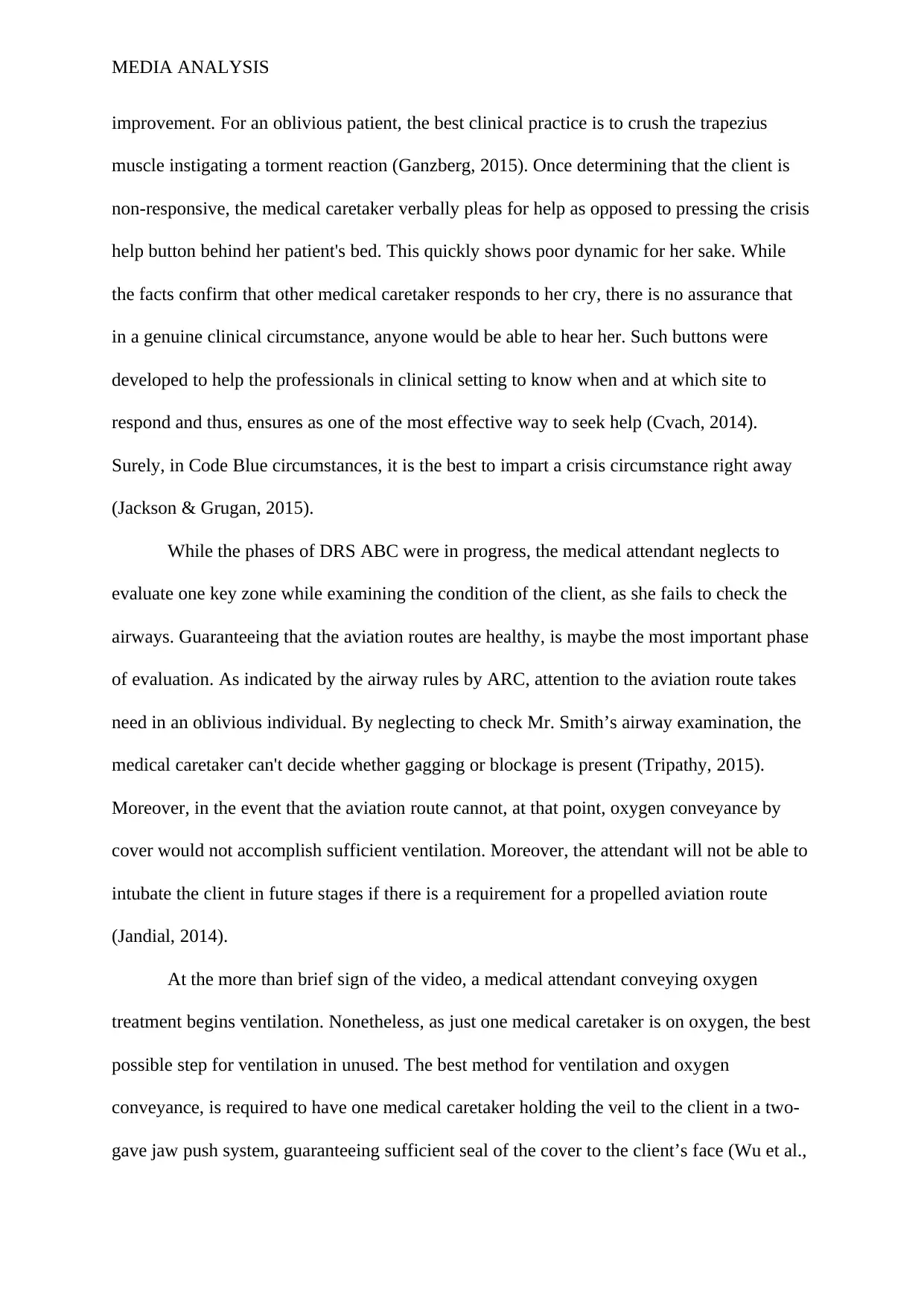
MEDIA ANALYSIS
improvement. For an oblivious patient, the best clinical practice is to crush the trapezius
muscle instigating a torment reaction (Ganzberg, 2015). Once determining that the client is
non-responsive, the medical caretaker verbally pleas for help as opposed to pressing the crisis
help button behind her patient's bed. This quickly shows poor dynamic for her sake. While
the facts confirm that other medical caretaker responds to her cry, there is no assurance that
in a genuine clinical circumstance, anyone would be able to hear her. Such buttons were
developed to help the professionals in clinical setting to know when and at which site to
respond and thus, ensures as one of the most effective way to seek help (Cvach, 2014).
Surely, in Code Blue circumstances, it is the best to impart a crisis circumstance right away
(Jackson & Grugan, 2015).
While the phases of DRS ABC were in progress, the medical attendant neglects to
evaluate one key zone while examining the condition of the client, as she fails to check the
airways. Guaranteeing that the aviation routes are healthy, is maybe the most important phase
of evaluation. As indicated by the airway rules by ARC, attention to the aviation route takes
need in an oblivious individual. By neglecting to check Mr. Smith’s airway examination, the
medical caretaker can't decide whether gagging or blockage is present (Tripathy, 2015).
Moreover, in the event that the aviation route cannot, at that point, oxygen conveyance by
cover would not accomplish sufficient ventilation. Moreover, the attendant will not be able to
intubate the client in future stages if there is a requirement for a propelled aviation route
(Jandial, 2014).
At the more than brief sign of the video, a medical attendant conveying oxygen
treatment begins ventilation. Nonetheless, as just one medical caretaker is on oxygen, the best
possible step for ventilation in unused. The best method for ventilation and oxygen
conveyance, is required to have one medical caretaker holding the veil to the client in a two-
gave jaw push system, guaranteeing sufficient seal of the cover to the client’s face (Wu et al.,
improvement. For an oblivious patient, the best clinical practice is to crush the trapezius
muscle instigating a torment reaction (Ganzberg, 2015). Once determining that the client is
non-responsive, the medical caretaker verbally pleas for help as opposed to pressing the crisis
help button behind her patient's bed. This quickly shows poor dynamic for her sake. While
the facts confirm that other medical caretaker responds to her cry, there is no assurance that
in a genuine clinical circumstance, anyone would be able to hear her. Such buttons were
developed to help the professionals in clinical setting to know when and at which site to
respond and thus, ensures as one of the most effective way to seek help (Cvach, 2014).
Surely, in Code Blue circumstances, it is the best to impart a crisis circumstance right away
(Jackson & Grugan, 2015).
While the phases of DRS ABC were in progress, the medical attendant neglects to
evaluate one key zone while examining the condition of the client, as she fails to check the
airways. Guaranteeing that the aviation routes are healthy, is maybe the most important phase
of evaluation. As indicated by the airway rules by ARC, attention to the aviation route takes
need in an oblivious individual. By neglecting to check Mr. Smith’s airway examination, the
medical caretaker can't decide whether gagging or blockage is present (Tripathy, 2015).
Moreover, in the event that the aviation route cannot, at that point, oxygen conveyance by
cover would not accomplish sufficient ventilation. Moreover, the attendant will not be able to
intubate the client in future stages if there is a requirement for a propelled aviation route
(Jandial, 2014).
At the more than brief sign of the video, a medical attendant conveying oxygen
treatment begins ventilation. Nonetheless, as just one medical caretaker is on oxygen, the best
possible step for ventilation in unused. The best method for ventilation and oxygen
conveyance, is required to have one medical caretaker holding the veil to the client in a two-
gave jaw push system, guaranteeing sufficient seal of the cover to the client’s face (Wu et al.,
⊘ This is a preview!⊘
Do you want full access?
Subscribe today to unlock all pages.

Trusted by 1+ million students worldwide
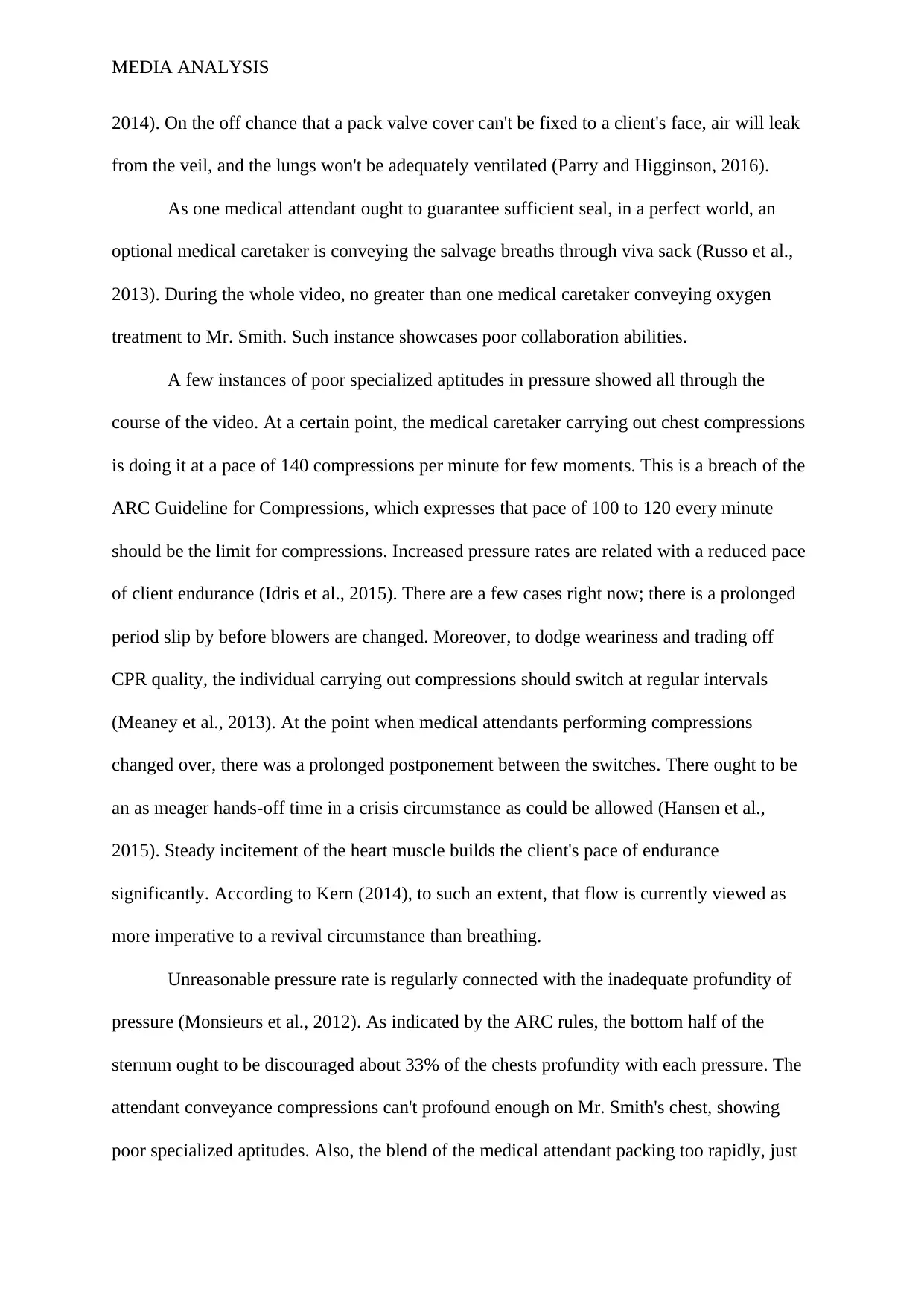
MEDIA ANALYSIS
2014). On the off chance that a pack valve cover can't be fixed to a client's face, air will leak
from the veil, and the lungs won't be adequately ventilated (Parry and Higginson, 2016).
As one medical attendant ought to guarantee sufficient seal, in a perfect world, an
optional medical caretaker is conveying the salvage breaths through viva sack (Russo et al.,
2013). During the whole video, no greater than one medical caretaker conveying oxygen
treatment to Mr. Smith. Such instance showcases poor collaboration abilities.
A few instances of poor specialized aptitudes in pressure showed all through the
course of the video. At a certain point, the medical caretaker carrying out chest compressions
is doing it at a pace of 140 compressions per minute for few moments. This is a breach of the
ARC Guideline for Compressions, which expresses that pace of 100 to 120 every minute
should be the limit for compressions. Increased pressure rates are related with a reduced pace
of client endurance (Idris et al., 2015). There are a few cases right now; there is a prolonged
period slip by before blowers are changed. Moreover, to dodge weariness and trading off
CPR quality, the individual carrying out compressions should switch at regular intervals
(Meaney et al., 2013). At the point when medical attendants performing compressions
changed over, there was a prolonged postponement between the switches. There ought to be
an as meager hands-off time in a crisis circumstance as could be allowed (Hansen et al.,
2015). Steady incitement of the heart muscle builds the client's pace of endurance
significantly. According to Kern (2014), to such an extent, that flow is currently viewed as
more imperative to a revival circumstance than breathing.
Unreasonable pressure rate is regularly connected with the inadequate profundity of
pressure (Monsieurs et al., 2012). As indicated by the ARC rules, the bottom half of the
sternum ought to be discouraged about 33% of the chests profundity with each pressure. The
attendant conveyance compressions can't profound enough on Mr. Smith's chest, showing
poor specialized aptitudes. Also, the blend of the medical attendant packing too rapidly, just
2014). On the off chance that a pack valve cover can't be fixed to a client's face, air will leak
from the veil, and the lungs won't be adequately ventilated (Parry and Higginson, 2016).
As one medical attendant ought to guarantee sufficient seal, in a perfect world, an
optional medical caretaker is conveying the salvage breaths through viva sack (Russo et al.,
2013). During the whole video, no greater than one medical caretaker conveying oxygen
treatment to Mr. Smith. Such instance showcases poor collaboration abilities.
A few instances of poor specialized aptitudes in pressure showed all through the
course of the video. At a certain point, the medical caretaker carrying out chest compressions
is doing it at a pace of 140 compressions per minute for few moments. This is a breach of the
ARC Guideline for Compressions, which expresses that pace of 100 to 120 every minute
should be the limit for compressions. Increased pressure rates are related with a reduced pace
of client endurance (Idris et al., 2015). There are a few cases right now; there is a prolonged
period slip by before blowers are changed. Moreover, to dodge weariness and trading off
CPR quality, the individual carrying out compressions should switch at regular intervals
(Meaney et al., 2013). At the point when medical attendants performing compressions
changed over, there was a prolonged postponement between the switches. There ought to be
an as meager hands-off time in a crisis circumstance as could be allowed (Hansen et al.,
2015). Steady incitement of the heart muscle builds the client's pace of endurance
significantly. According to Kern (2014), to such an extent, that flow is currently viewed as
more imperative to a revival circumstance than breathing.
Unreasonable pressure rate is regularly connected with the inadequate profundity of
pressure (Monsieurs et al., 2012). As indicated by the ARC rules, the bottom half of the
sternum ought to be discouraged about 33% of the chests profundity with each pressure. The
attendant conveyance compressions can't profound enough on Mr. Smith's chest, showing
poor specialized aptitudes. Also, the blend of the medical attendant packing too rapidly, just
Paraphrase This Document
Need a fresh take? Get an instant paraphrase of this document with our AI Paraphraser
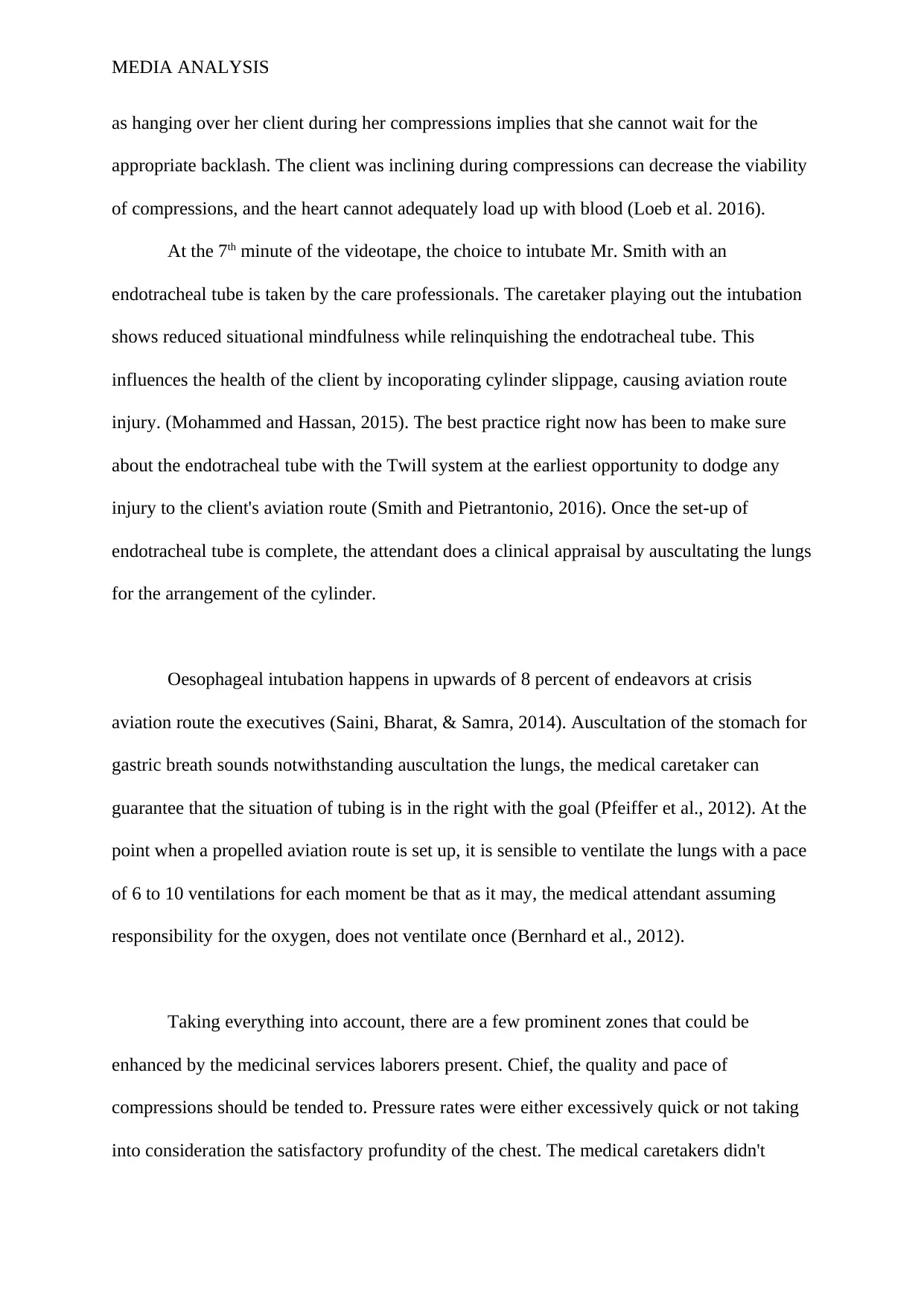
MEDIA ANALYSIS
as hanging over her client during her compressions implies that she cannot wait for the
appropriate backlash. The client was inclining during compressions can decrease the viability
of compressions, and the heart cannot adequately load up with blood (Loeb et al. 2016).
At the 7th minute of the videotape, the choice to intubate Mr. Smith with an
endotracheal tube is taken by the care professionals. The caretaker playing out the intubation
shows reduced situational mindfulness while relinquishing the endotracheal tube. This
influences the health of the client by incoporating cylinder slippage, causing aviation route
injury. (Mohammed and Hassan, 2015). The best practice right now has been to make sure
about the endotracheal tube with the Twill system at the earliest opportunity to dodge any
injury to the client's aviation route (Smith and Pietrantonio, 2016). Once the set-up of
endotracheal tube is complete, the attendant does a clinical appraisal by auscultating the lungs
for the arrangement of the cylinder.
Oesophageal intubation happens in upwards of 8 percent of endeavors at crisis
aviation route the executives (Saini, Bharat, & Samra, 2014). Auscultation of the stomach for
gastric breath sounds notwithstanding auscultation the lungs, the medical caretaker can
guarantee that the situation of tubing is in the right with the goal (Pfeiffer et al., 2012). At the
point when a propelled aviation route is set up, it is sensible to ventilate the lungs with a pace
of 6 to 10 ventilations for each moment be that as it may, the medical attendant assuming
responsibility for the oxygen, does not ventilate once (Bernhard et al., 2012).
Taking everything into account, there are a few prominent zones that could be
enhanced by the medicinal services laborers present. Chief, the quality and pace of
compressions should be tended to. Pressure rates were either excessively quick or not taking
into consideration the satisfactory profundity of the chest. The medical caretakers didn't
as hanging over her client during her compressions implies that she cannot wait for the
appropriate backlash. The client was inclining during compressions can decrease the viability
of compressions, and the heart cannot adequately load up with blood (Loeb et al. 2016).
At the 7th minute of the videotape, the choice to intubate Mr. Smith with an
endotracheal tube is taken by the care professionals. The caretaker playing out the intubation
shows reduced situational mindfulness while relinquishing the endotracheal tube. This
influences the health of the client by incoporating cylinder slippage, causing aviation route
injury. (Mohammed and Hassan, 2015). The best practice right now has been to make sure
about the endotracheal tube with the Twill system at the earliest opportunity to dodge any
injury to the client's aviation route (Smith and Pietrantonio, 2016). Once the set-up of
endotracheal tube is complete, the attendant does a clinical appraisal by auscultating the lungs
for the arrangement of the cylinder.
Oesophageal intubation happens in upwards of 8 percent of endeavors at crisis
aviation route the executives (Saini, Bharat, & Samra, 2014). Auscultation of the stomach for
gastric breath sounds notwithstanding auscultation the lungs, the medical caretaker can
guarantee that the situation of tubing is in the right with the goal (Pfeiffer et al., 2012). At the
point when a propelled aviation route is set up, it is sensible to ventilate the lungs with a pace
of 6 to 10 ventilations for each moment be that as it may, the medical attendant assuming
responsibility for the oxygen, does not ventilate once (Bernhard et al., 2012).
Taking everything into account, there are a few prominent zones that could be
enhanced by the medicinal services laborers present. Chief, the quality and pace of
compressions should be tended to. Pressure rates were either excessively quick or not taking
into consideration the satisfactory profundity of the chest. The medical caretakers didn't
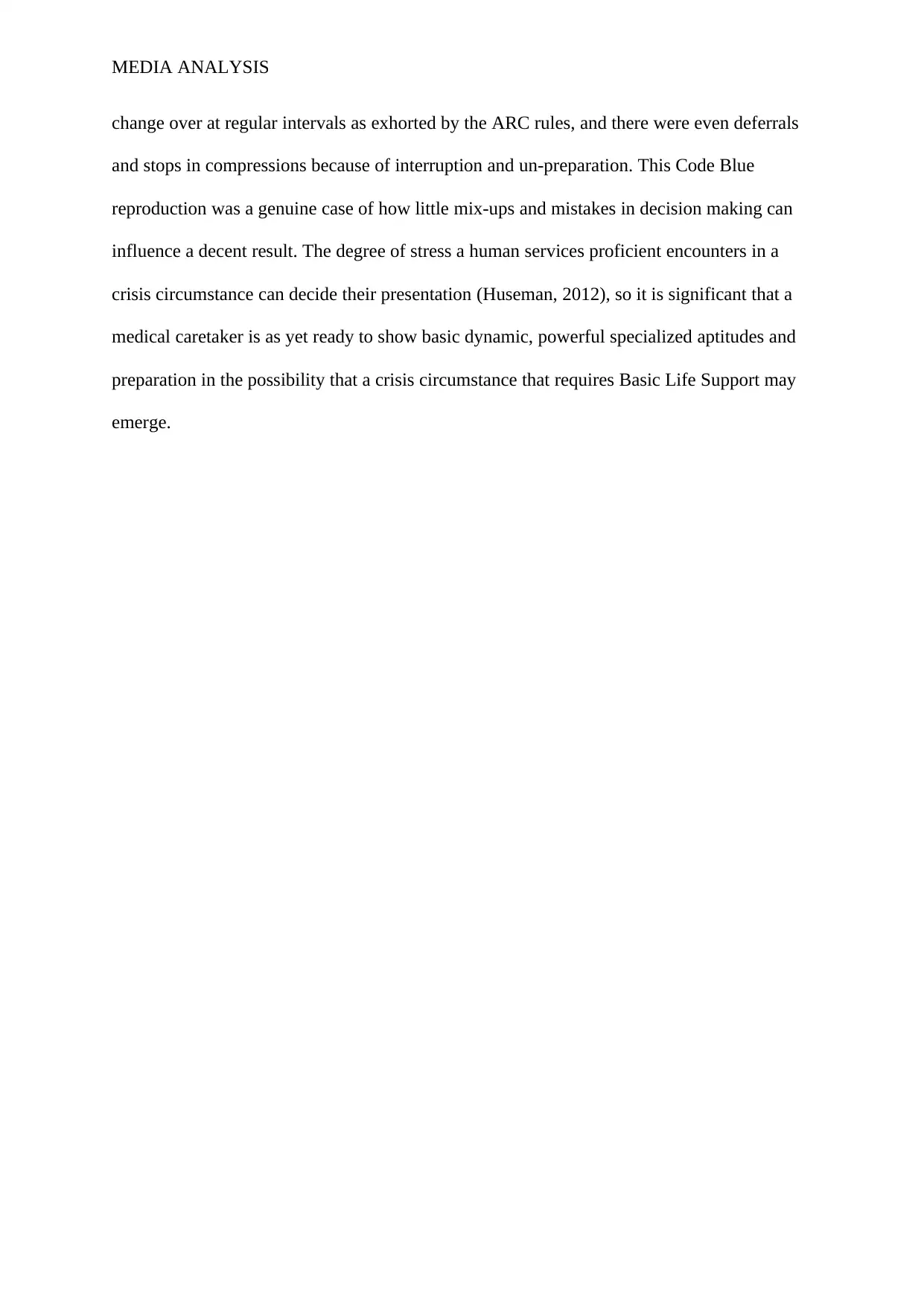
MEDIA ANALYSIS
change over at regular intervals as exhorted by the ARC rules, and there were even deferrals
and stops in compressions because of interruption and un-preparation. This Code Blue
reproduction was a genuine case of how little mix-ups and mistakes in decision making can
influence a decent result. The degree of stress a human services proficient encounters in a
crisis circumstance can decide their presentation (Huseman, 2012), so it is significant that a
medical caretaker is as yet ready to show basic dynamic, powerful specialized aptitudes and
preparation in the possibility that a crisis circumstance that requires Basic Life Support may
emerge.
change over at regular intervals as exhorted by the ARC rules, and there were even deferrals
and stops in compressions because of interruption and un-preparation. This Code Blue
reproduction was a genuine case of how little mix-ups and mistakes in decision making can
influence a decent result. The degree of stress a human services proficient encounters in a
crisis circumstance can decide their presentation (Huseman, 2012), so it is significant that a
medical caretaker is as yet ready to show basic dynamic, powerful specialized aptitudes and
preparation in the possibility that a crisis circumstance that requires Basic Life Support may
emerge.
⊘ This is a preview!⊘
Do you want full access?
Subscribe today to unlock all pages.

Trusted by 1+ million students worldwide
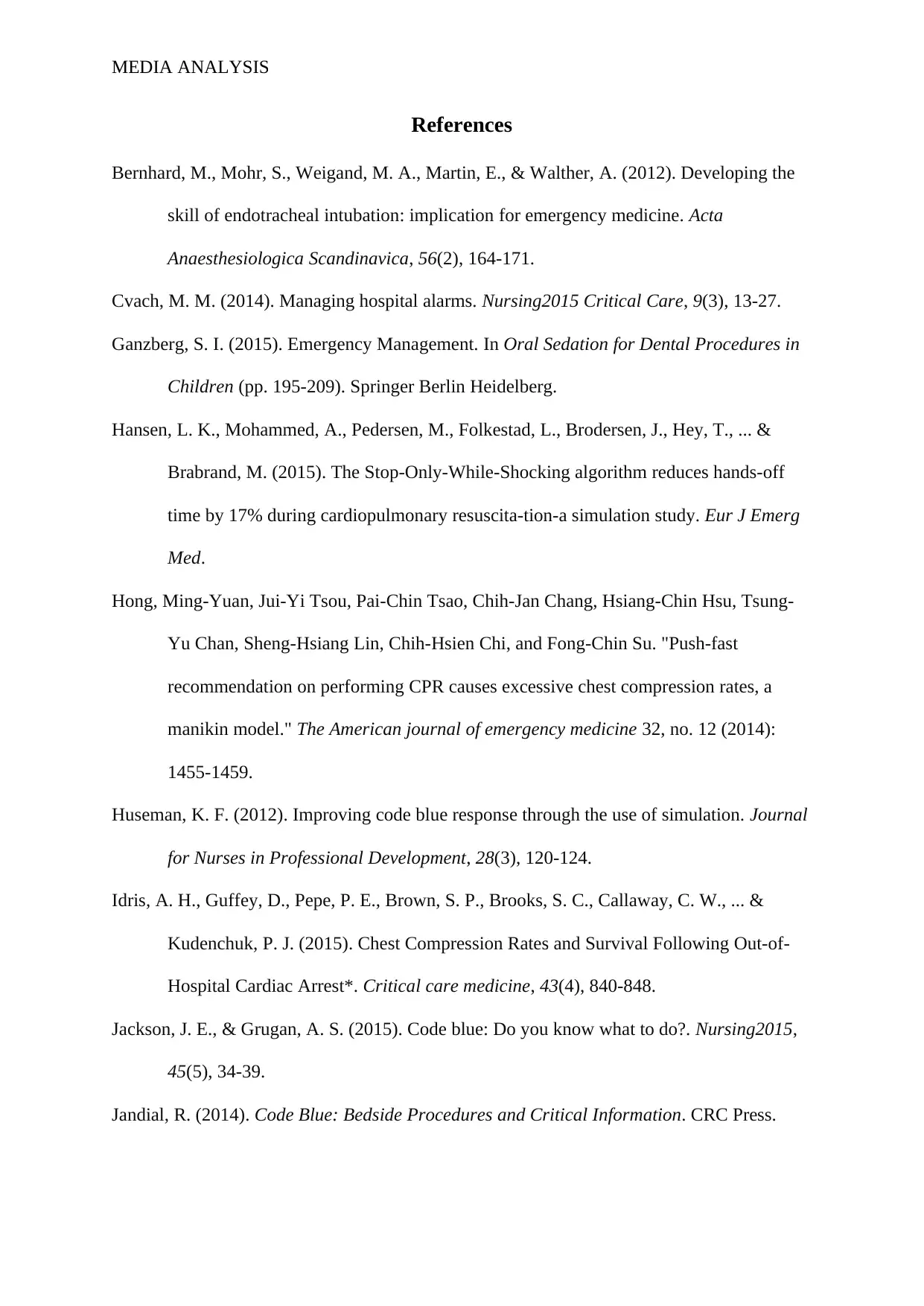
MEDIA ANALYSIS
References
Bernhard, M., Mohr, S., Weigand, M. A., Martin, E., & Walther, A. (2012). Developing the
skill of endotracheal intubation: implication for emergency medicine. Acta
Anaesthesiologica Scandinavica, 56(2), 164-171.
Cvach, M. M. (2014). Managing hospital alarms. Nursing2015 Critical Care, 9(3), 13-27.
Ganzberg, S. I. (2015). Emergency Management. In Oral Sedation for Dental Procedures in
Children (pp. 195-209). Springer Berlin Heidelberg.
Hansen, L. K., Mohammed, A., Pedersen, M., Folkestad, L., Brodersen, J., Hey, T., ... &
Brabrand, M. (2015). The Stop-Only-While-Shocking algorithm reduces hands-off
time by 17% during cardiopulmonary resuscita-tion-a simulation study. Eur J Emerg
Med.
Hong, Ming-Yuan, Jui-Yi Tsou, Pai-Chin Tsao, Chih-Jan Chang, Hsiang-Chin Hsu, Tsung-
Yu Chan, Sheng-Hsiang Lin, Chih-Hsien Chi, and Fong-Chin Su. "Push-fast
recommendation on performing CPR causes excessive chest compression rates, a
manikin model." The American journal of emergency medicine 32, no. 12 (2014):
1455-1459.
Huseman, K. F. (2012). Improving code blue response through the use of simulation. Journal
for Nurses in Professional Development, 28(3), 120-124.
Idris, A. H., Guffey, D., Pepe, P. E., Brown, S. P., Brooks, S. C., Callaway, C. W., ... &
Kudenchuk, P. J. (2015). Chest Compression Rates and Survival Following Out-of-
Hospital Cardiac Arrest*. Critical care medicine, 43(4), 840-848.
Jackson, J. E., & Grugan, A. S. (2015). Code blue: Do you know what to do?. Nursing2015,
45(5), 34-39.
Jandial, R. (2014). Code Blue: Bedside Procedures and Critical Information. CRC Press.
References
Bernhard, M., Mohr, S., Weigand, M. A., Martin, E., & Walther, A. (2012). Developing the
skill of endotracheal intubation: implication for emergency medicine. Acta
Anaesthesiologica Scandinavica, 56(2), 164-171.
Cvach, M. M. (2014). Managing hospital alarms. Nursing2015 Critical Care, 9(3), 13-27.
Ganzberg, S. I. (2015). Emergency Management. In Oral Sedation for Dental Procedures in
Children (pp. 195-209). Springer Berlin Heidelberg.
Hansen, L. K., Mohammed, A., Pedersen, M., Folkestad, L., Brodersen, J., Hey, T., ... &
Brabrand, M. (2015). The Stop-Only-While-Shocking algorithm reduces hands-off
time by 17% during cardiopulmonary resuscita-tion-a simulation study. Eur J Emerg
Med.
Hong, Ming-Yuan, Jui-Yi Tsou, Pai-Chin Tsao, Chih-Jan Chang, Hsiang-Chin Hsu, Tsung-
Yu Chan, Sheng-Hsiang Lin, Chih-Hsien Chi, and Fong-Chin Su. "Push-fast
recommendation on performing CPR causes excessive chest compression rates, a
manikin model." The American journal of emergency medicine 32, no. 12 (2014):
1455-1459.
Huseman, K. F. (2012). Improving code blue response through the use of simulation. Journal
for Nurses in Professional Development, 28(3), 120-124.
Idris, A. H., Guffey, D., Pepe, P. E., Brown, S. P., Brooks, S. C., Callaway, C. W., ... &
Kudenchuk, P. J. (2015). Chest Compression Rates and Survival Following Out-of-
Hospital Cardiac Arrest*. Critical care medicine, 43(4), 840-848.
Jackson, J. E., & Grugan, A. S. (2015). Code blue: Do you know what to do?. Nursing2015,
45(5), 34-39.
Jandial, R. (2014). Code Blue: Bedside Procedures and Critical Information. CRC Press.
Paraphrase This Document
Need a fresh take? Get an instant paraphrase of this document with our AI Paraphraser
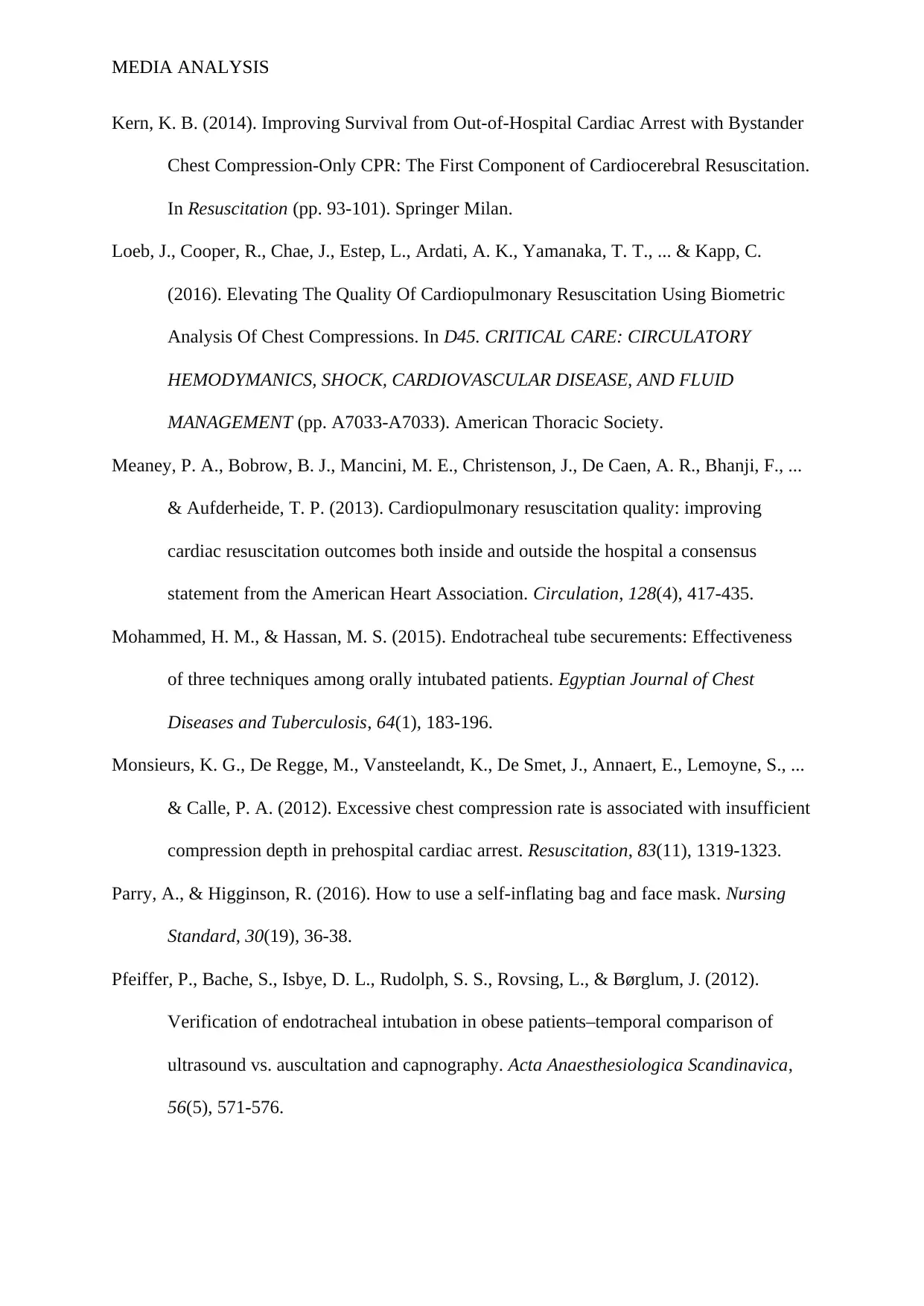
MEDIA ANALYSIS
Kern, K. B. (2014). Improving Survival from Out-of-Hospital Cardiac Arrest with Bystander
Chest Compression-Only CPR: The First Component of Cardiocerebral Resuscitation.
In Resuscitation (pp. 93-101). Springer Milan.
Loeb, J., Cooper, R., Chae, J., Estep, L., Ardati, A. K., Yamanaka, T. T., ... & Kapp, C.
(2016). Elevating The Quality Of Cardiopulmonary Resuscitation Using Biometric
Analysis Of Chest Compressions. In D45. CRITICAL CARE: CIRCULATORY
HEMODYMANICS, SHOCK, CARDIOVASCULAR DISEASE, AND FLUID
MANAGEMENT (pp. A7033-A7033). American Thoracic Society.
Meaney, P. A., Bobrow, B. J., Mancini, M. E., Christenson, J., De Caen, A. R., Bhanji, F., ...
& Aufderheide, T. P. (2013). Cardiopulmonary resuscitation quality: improving
cardiac resuscitation outcomes both inside and outside the hospital a consensus
statement from the American Heart Association. Circulation, 128(4), 417-435.
Mohammed, H. M., & Hassan, M. S. (2015). Endotracheal tube securements: Effectiveness
of three techniques among orally intubated patients. Egyptian Journal of Chest
Diseases and Tuberculosis, 64(1), 183-196.
Monsieurs, K. G., De Regge, M., Vansteelandt, K., De Smet, J., Annaert, E., Lemoyne, S., ...
& Calle, P. A. (2012). Excessive chest compression rate is associated with insufficient
compression depth in prehospital cardiac arrest. Resuscitation, 83(11), 1319-1323.
Parry, A., & Higginson, R. (2016). How to use a self-inflating bag and face mask. Nursing
Standard, 30(19), 36-38.
Pfeiffer, P., Bache, S., Isbye, D. L., Rudolph, S. S., Rovsing, L., & Børglum, J. (2012).
Verification of endotracheal intubation in obese patients–temporal comparison of
ultrasound vs. auscultation and capnography. Acta Anaesthesiologica Scandinavica,
56(5), 571-576.
Kern, K. B. (2014). Improving Survival from Out-of-Hospital Cardiac Arrest with Bystander
Chest Compression-Only CPR: The First Component of Cardiocerebral Resuscitation.
In Resuscitation (pp. 93-101). Springer Milan.
Loeb, J., Cooper, R., Chae, J., Estep, L., Ardati, A. K., Yamanaka, T. T., ... & Kapp, C.
(2016). Elevating The Quality Of Cardiopulmonary Resuscitation Using Biometric
Analysis Of Chest Compressions. In D45. CRITICAL CARE: CIRCULATORY
HEMODYMANICS, SHOCK, CARDIOVASCULAR DISEASE, AND FLUID
MANAGEMENT (pp. A7033-A7033). American Thoracic Society.
Meaney, P. A., Bobrow, B. J., Mancini, M. E., Christenson, J., De Caen, A. R., Bhanji, F., ...
& Aufderheide, T. P. (2013). Cardiopulmonary resuscitation quality: improving
cardiac resuscitation outcomes both inside and outside the hospital a consensus
statement from the American Heart Association. Circulation, 128(4), 417-435.
Mohammed, H. M., & Hassan, M. S. (2015). Endotracheal tube securements: Effectiveness
of three techniques among orally intubated patients. Egyptian Journal of Chest
Diseases and Tuberculosis, 64(1), 183-196.
Monsieurs, K. G., De Regge, M., Vansteelandt, K., De Smet, J., Annaert, E., Lemoyne, S., ...
& Calle, P. A. (2012). Excessive chest compression rate is associated with insufficient
compression depth in prehospital cardiac arrest. Resuscitation, 83(11), 1319-1323.
Parry, A., & Higginson, R. (2016). How to use a self-inflating bag and face mask. Nursing
Standard, 30(19), 36-38.
Pfeiffer, P., Bache, S., Isbye, D. L., Rudolph, S. S., Rovsing, L., & Børglum, J. (2012).
Verification of endotracheal intubation in obese patients–temporal comparison of
ultrasound vs. auscultation and capnography. Acta Anaesthesiologica Scandinavica,
56(5), 571-576.
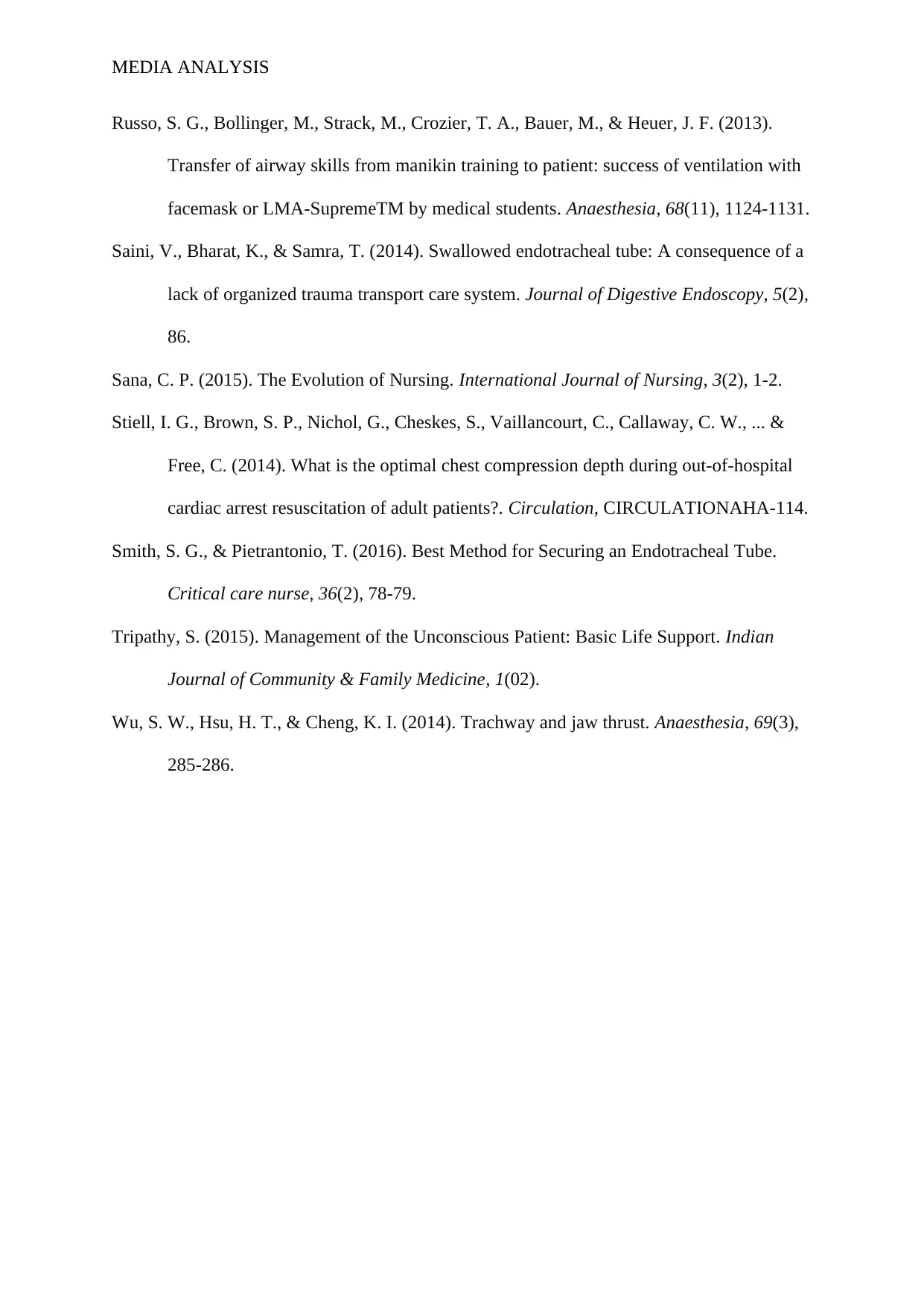
MEDIA ANALYSIS
Russo, S. G., Bollinger, M., Strack, M., Crozier, T. A., Bauer, M., & Heuer, J. F. (2013).
Transfer of airway skills from manikin training to patient: success of ventilation with
facemask or LMA‐SupremeTM by medical students. Anaesthesia, 68(11), 1124-1131.
Saini, V., Bharat, K., & Samra, T. (2014). Swallowed endotracheal tube: A consequence of a
lack of organized trauma transport care system. Journal of Digestive Endoscopy, 5(2),
86.
Sana, C. P. (2015). The Evolution of Nursing. International Journal of Nursing, 3(2), 1-2.
Stiell, I. G., Brown, S. P., Nichol, G., Cheskes, S., Vaillancourt, C., Callaway, C. W., ... &
Free, C. (2014). What is the optimal chest compression depth during out-of-hospital
cardiac arrest resuscitation of adult patients?. Circulation, CIRCULATIONAHA-114.
Smith, S. G., & Pietrantonio, T. (2016). Best Method for Securing an Endotracheal Tube.
Critical care nurse, 36(2), 78-79.
Tripathy, S. (2015). Management of the Unconscious Patient: Basic Life Support. Indian
Journal of Community & Family Medicine, 1(02).
Wu, S. W., Hsu, H. T., & Cheng, K. I. (2014). Trachway and jaw thrust. Anaesthesia, 69(3),
285-286.
Russo, S. G., Bollinger, M., Strack, M., Crozier, T. A., Bauer, M., & Heuer, J. F. (2013).
Transfer of airway skills from manikin training to patient: success of ventilation with
facemask or LMA‐SupremeTM by medical students. Anaesthesia, 68(11), 1124-1131.
Saini, V., Bharat, K., & Samra, T. (2014). Swallowed endotracheal tube: A consequence of a
lack of organized trauma transport care system. Journal of Digestive Endoscopy, 5(2),
86.
Sana, C. P. (2015). The Evolution of Nursing. International Journal of Nursing, 3(2), 1-2.
Stiell, I. G., Brown, S. P., Nichol, G., Cheskes, S., Vaillancourt, C., Callaway, C. W., ... &
Free, C. (2014). What is the optimal chest compression depth during out-of-hospital
cardiac arrest resuscitation of adult patients?. Circulation, CIRCULATIONAHA-114.
Smith, S. G., & Pietrantonio, T. (2016). Best Method for Securing an Endotracheal Tube.
Critical care nurse, 36(2), 78-79.
Tripathy, S. (2015). Management of the Unconscious Patient: Basic Life Support. Indian
Journal of Community & Family Medicine, 1(02).
Wu, S. W., Hsu, H. T., & Cheng, K. I. (2014). Trachway and jaw thrust. Anaesthesia, 69(3),
285-286.
⊘ This is a preview!⊘
Do you want full access?
Subscribe today to unlock all pages.

Trusted by 1+ million students worldwide
1 out of 9
Your All-in-One AI-Powered Toolkit for Academic Success.
+13062052269
info@desklib.com
Available 24*7 on WhatsApp / Email
![[object Object]](/_next/static/media/star-bottom.7253800d.svg)
Unlock your academic potential
Copyright © 2020–2025 A2Z Services. All Rights Reserved. Developed and managed by ZUCOL.
